How I became a Scottish thatcher
Skills | Written by: Troy Holt | Tuesday 28 October 2025
Caring for and maintaining Scotland’s beautiful thatched buildings is more challenging than you might think. Only around 250 thatched buildings remain in Scotland and few thatchers can make ends meet doing thatching on its own.
In this blog Troy Holt, our former Thatching and Dry Stone Walling Craft Fellow, shares how he found his way into thatching, what skills he has learned and why he is passionate about this critically endangered traditional craft skill.
How I discovered thatching
Like many thatchers in Scotland, you kind of fall into it rather than find it. I don’t know of any thatcher that decided in school that they wanted to do thatching. I fell into thatching after I graduated from Glasgow University. I had gained a degree in English Literature and Philosophy but had no idea what to do with it.
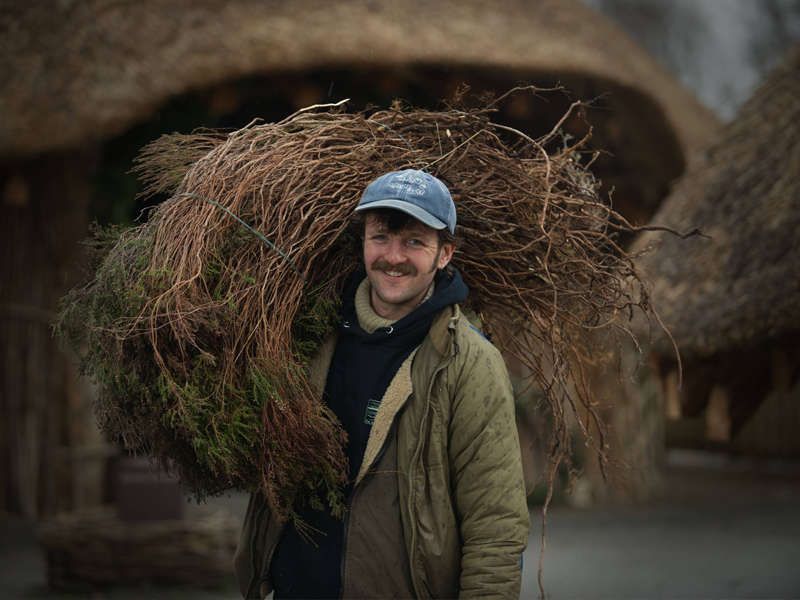
Troy, carrying heather for thatch at the Scottish Crannog Centre, Loch Tay © Rob McDougall.
I had a conversation with a friend at the uni swimming pool and said offhand that I was interested in eco-house building and sustainable building (designing and constructing homes that minimize environmental impact through the use of sustainable materials and energy-efficient technologies). She told me that it wasn’t quite eco-house building, but that her dad did historic and traditional building. Her dad turned out to be Master Thatcher and Dyker, Brian Wilson. We ended up meeting and getting along. I started working with Brian at the start of 2023 for a few weeks here and there at first, and then we got a job to do Lonbain Cottage, near Applecross on Skye.
Thatching Lonbain Cottage
Brian and I started the process of totally rethatching Lonbain Cottage and we did a big heather pick for that. Heather thatching is a practice almost unique to the northwest of Scotland, with some examples in northern England. We pick heather specifically for thatching ourselves as you cannot buy it in and it must be done by hand. It was during that pick that I decided that I wanted to do thatching full-time if I could. To do that, it would mean going and looking for funding, which then put me on to the Historic Environment Scotland (HES) Craft Fellowship programme. Through the programme’s support, Brian became the host for my Craft Fellowship.
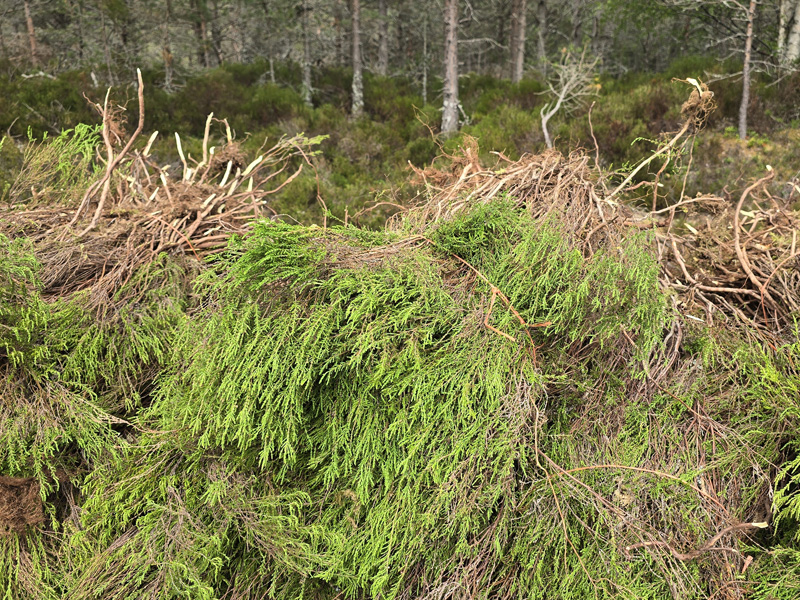
A pile of heather bundles, picked at Mar Lodge Estate National Nature Reserve, National Trust for Scotland (NTS).
Learning other traditional building skills
I was on the programme for 18 months, and in that time I was exposed to so many fantastic opportunities and people in a way that is very encouraging of you to engage in your own ideas and projects.
The skills you learn thatching are all the front-end traditional craft stuff. So, there is the thatching, including heather thatching. We have also thatched with reed and I have done a little bit with bracken off my own bat. Thatching does not make up the majority of our work because it is impossible to make a living from it alone in Scotland. There are only a few hundred thatched buildings, so, we end up doing a lot of other stuff.
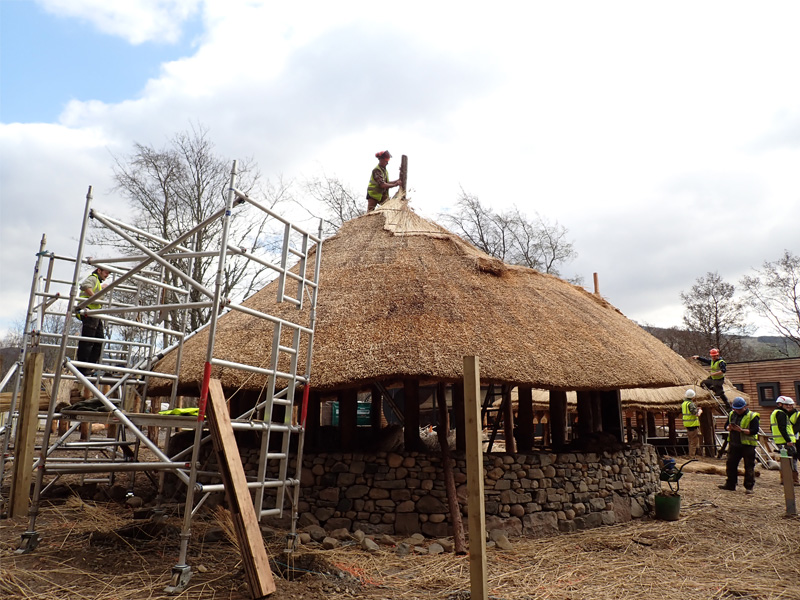
Brian Wilson reed thatching a hut assisted by Troy at the Scottish Crannog Centre’s Iron Age Village build, Loch Tay.
There’s timber framing, working with turf, stonework and drystone dyking or drystone walling (a traditional building technique where structures are constructed using stones without mortar or cement). Outside of that, there is also the planning side of things. The way that we run things on site is quite unusual because we do not have a usual workplace. We are travelling around quite a lot with all of our equipment. There needs to be a lot of planning involved.
So, it has been a kind of all-encompassing experience.
“It has made me appreciate the heritage and the built landscape in a very sort of intimate way because you are so involved in these old buildings and in these old practices that you really come to care and you cannot help but care.”
Working on new and traditional buildings
There is the old stuff, like Lonbain Cottage near Applecross, Leanach Cottage at Culloden and Hugh Millar’s Birthplace Cottage and Museum which are definitely the most interesting, for me at least. But then there are also those built with a heritage flavour that were new builds but built to look like old style houses that had heather thatches and had the kind of older style of stonework. There have also been some community buildings as well. And, a lot of dry stone walls!
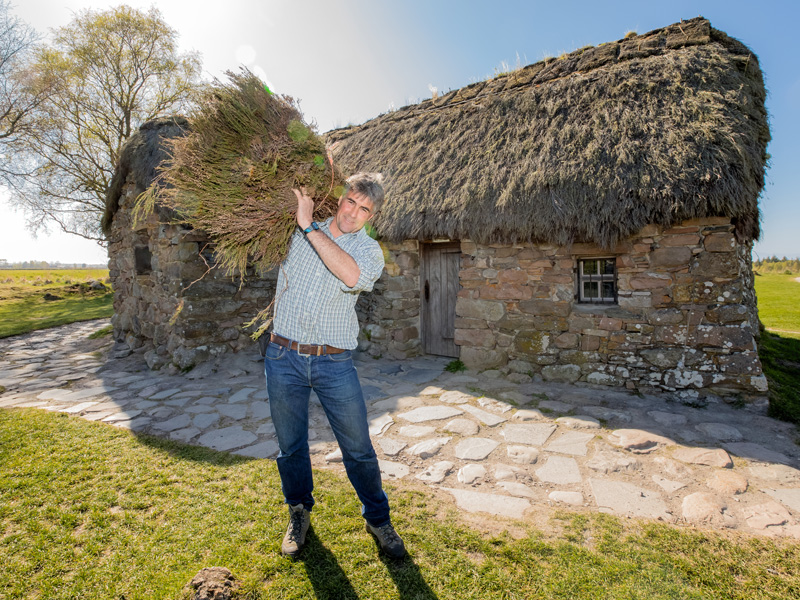
Brian Wilson at Leanach Cottage on Culloden Battlefield. An example of a heather thatched building © Malcolm McCurrach.
Collaborating and passing skills to others
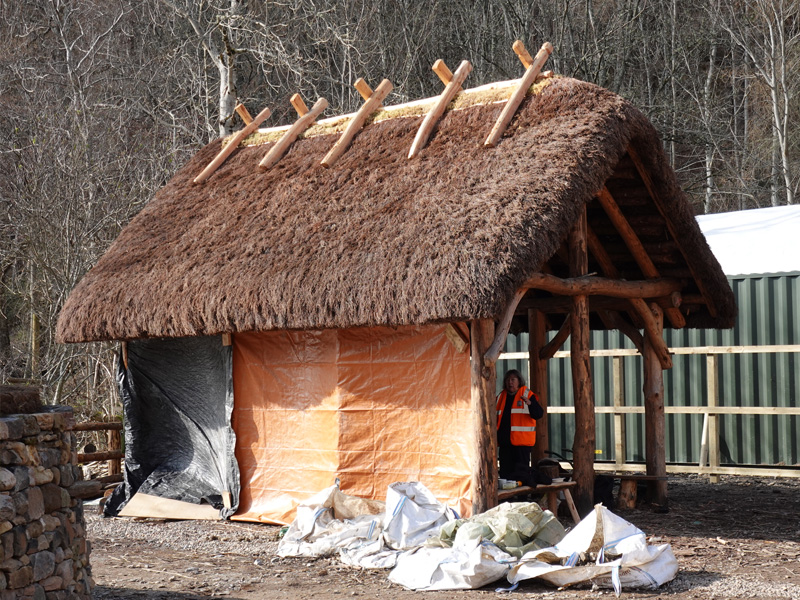
Heather thatched shelter at the Scottish Crannog Centre, with decorated wooden ridge.
I worked with Cat Hotchkiss, who was the HES Vernacular Buildings Craft Fellow, at the Scottish Crannog Centre, Loch Tay, on some heather thatching. We actually thatched a small building together, a little duck house whilst Brian worked on a second hut. And then there has also been friends coming up to visit. But overall, the heather picking is probably the main skill I have passed on to others. That has been the regular thing every year, getting a band together of about eight people to do heather picking. This has introduced a whole bunch of people to the craft. And, some of those people have gone on to do a little bit of thatching with us.
Update your personalised ad preferences to view content
A deeper understanding of shelter and environment
“I think thatching has really opened my eyes to the idea of shelter and what that means in a very sort of broad and philosophical way.”
It is just giving me a certain understanding about shelter and the environment and building with these traditional craft skills.
Using natural materials, they are typically more environmentally friendly than modern building techniques, and so it puts you in contact and connection with the natural landscape, and in a way that I think is quite hard to achieve otherwise. You cannot help but care about these buildings and about these crafts because you are so involved in it. But then because of that, you end up caring about how the heather’s growing because you need the heather to be thriving and in order for the heather to be doing well, the rest of the landscape needs to be doing well. This then connects you to the trees and all the animals and things. So, it is a very kind of interconnected practice.
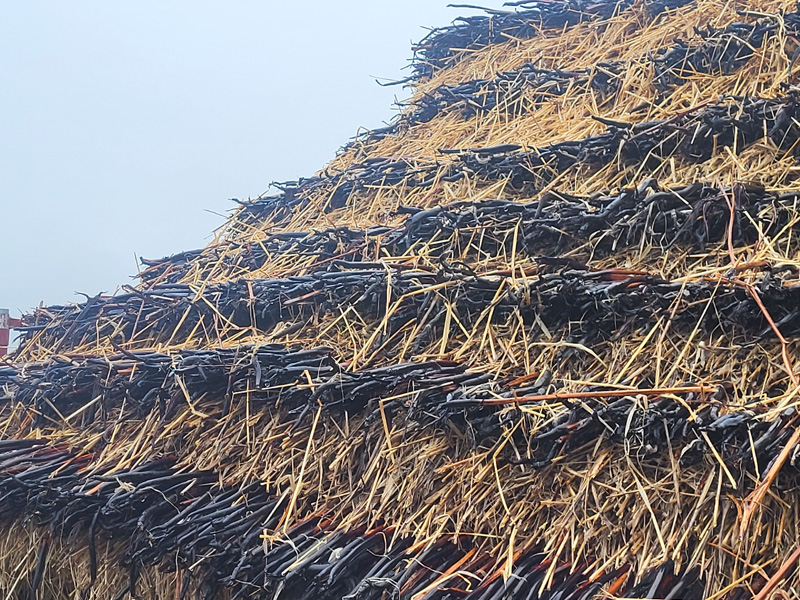
Example of bracken thatching on a cuppilled wooden roof frame at Comrie Croft grassroots hutting project, Perthshire.
What is next for me?
I would love to keep doing this at least for the rest of this season. I am currently applying for funding to keep going. Brian has some work for me, but he cannot afford to keep me on for all of it. If that does not come through, then I will probably go self-employed and just try to make it work.
I’d like to go to the next International Thatching Society (ITS) meetup because I’d quite like to meet people who practice it in other countries and learn more. I would like to find out what is different about my version of thatching versus their version because the differences can be so interesting.
Find out more
Find out about our Craft Fellowship programme or host a Craft Fellow and read Troy’s blog on how to pick heather for thatching.
About the author:
Troy Holt
Troy Holt is our former Thatching and Drystone Dyking Craft Fellow, part of our Trainee and Craft Fellowship Programme. He is hosted by Master Thatcher and Dyker Brian Wilson. Troy has a MA in English Literature and Philosophy from the University of Glasgow. His work involves maintaining and repairing both traditional and new buildings. His work supports the retention of critically endangered thatching skills and practices in Scotland, and a range of traditional building crafts.
View all posts by Troy Holt



